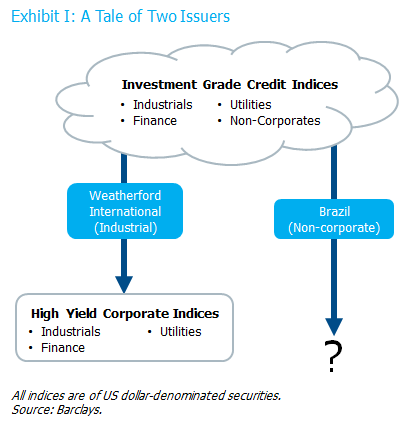Brazil’s sovereign debt was recently downgraded below investment grade (IG). Before the downgrade, its index-eligible bonds were included in both the Barclays US Credit Investment Grade Index and the JPMorgan Emerging Market Bond Index, two of the more commonly followed indices. Beginning 1/1/16, these bonds will fall out of the IG index. What happens next is perhaps surprising.
There is an important distinction in the process that occurs when corporate debt gets downgraded to below IG versus when non-corporate debt (e.g., sovereign, supranational, and taxable municipal debt) does. For the corporate borrower, its debt moves bond for bond into the Barclays US Corporate High Yield Index. Accordingly, when a corporate issuer is downgraded to below IG, some investors are forced (or incented) to sell its bonds, but natural buyers are created in the ranks of high yield managers. On the other hand, non-corporate debt that is below IG has no new natural buyers when it becomes “junk” because it will not be added to any widely accepted non-IG indices. Of course, it remains in emerging market indices (e.g. the JPMorgan Emerging Market Bond Index or the Barclays Emerging Market USD Aggregate), but this does not create any new demand.
So what? Intuitively, it makes sense that the “hand off” between seller and buyer will be smoother in the case of a corporate downgrade from IG than for a non-corporate. The graphic below illustrates this reality, with Weatherford International, an oilfield services company downgraded from investment grade in November, serving as our illustrative corporate issuer.

Returning to Brazil, its bonds have performed poorly for quite some time. It will be interesting to see their price performance in the trading days around year-end.
We are not ringing an alarm to sell non-corporate bonds. The added diversification of a portfolio that includes non-corporates may be appealing, and over an extended period of time we have found excellent relative value investment opportunities within the non-corporate sectors. We also believe that the construction and constituent rules of the IG and high yield indices may present additional relative value trading opportunities for the diligent investor during the period surrounding a downgrade. From NISA’s perspective, it’s useful to keep in mind the IG/below IG dynamic, given that non-corporate bonds have a material presence in most credit indices.
To download a PDF version, please click here.



